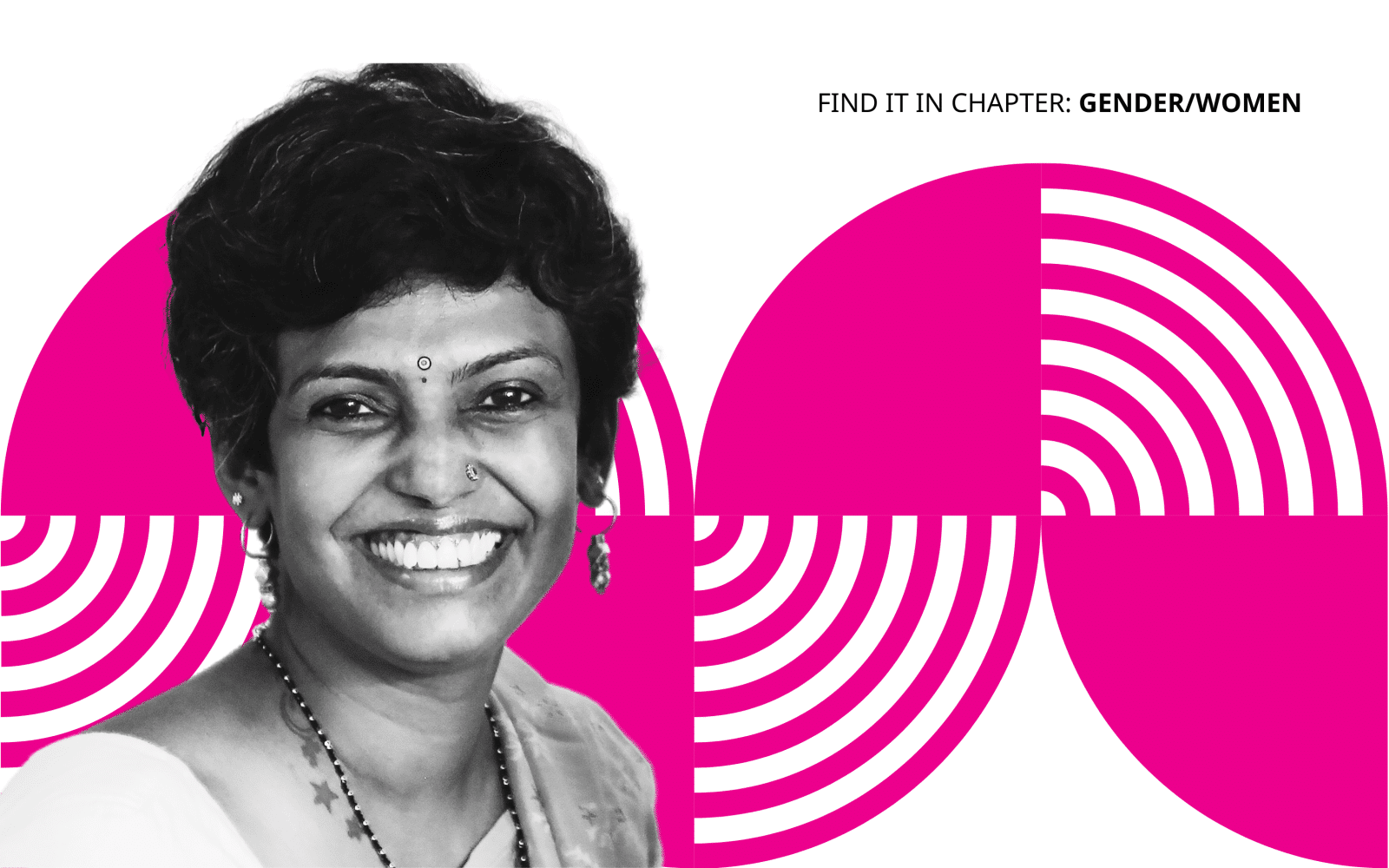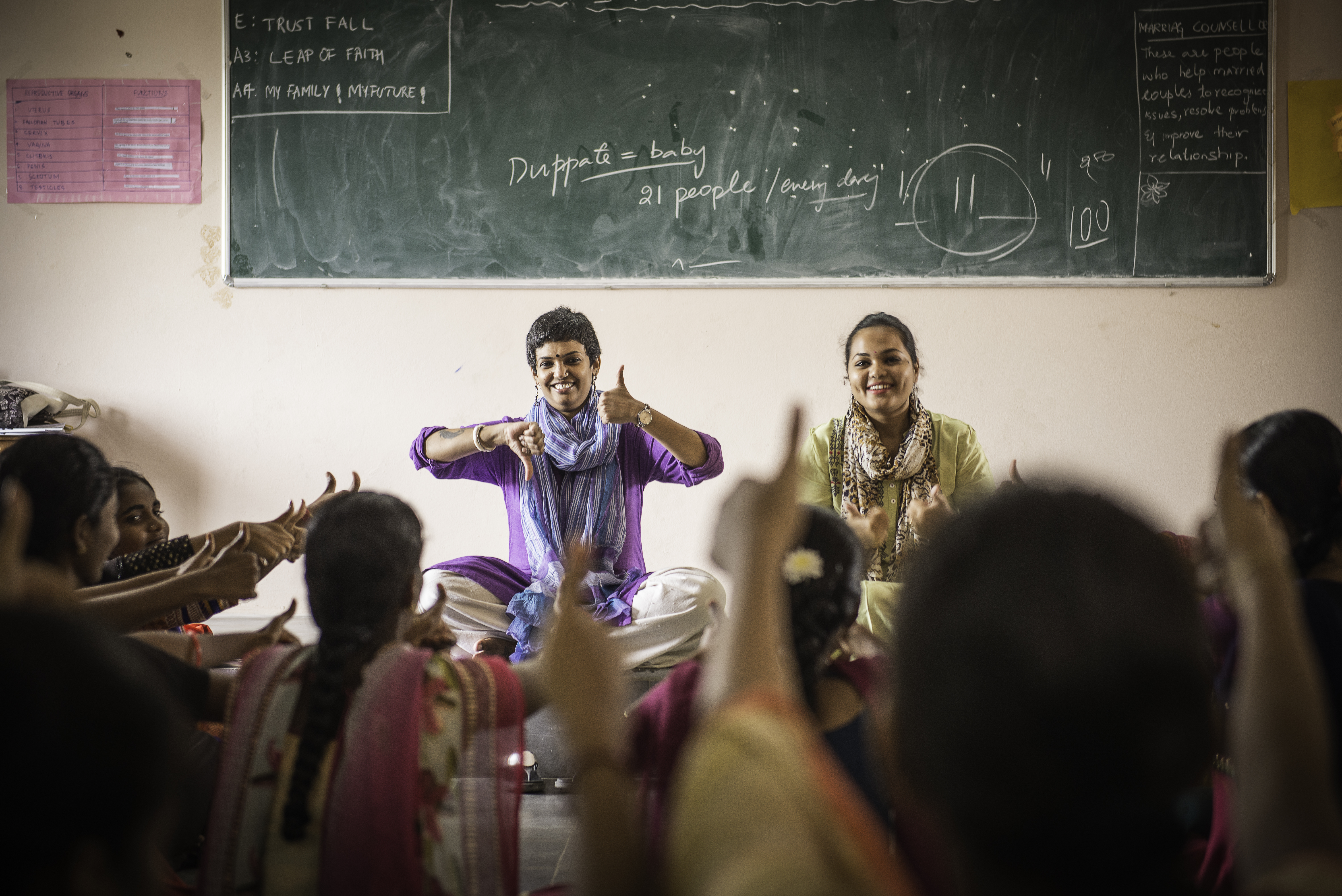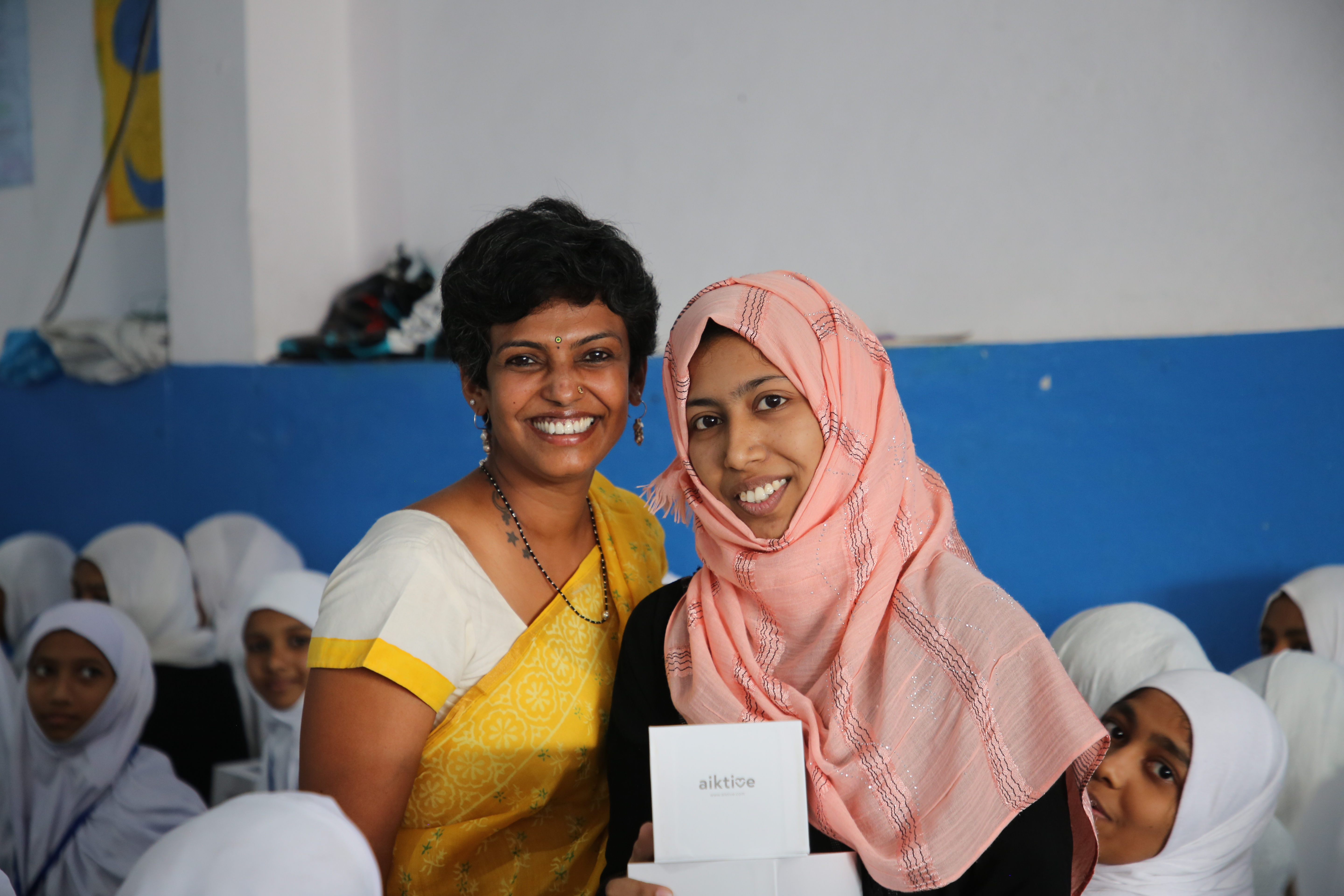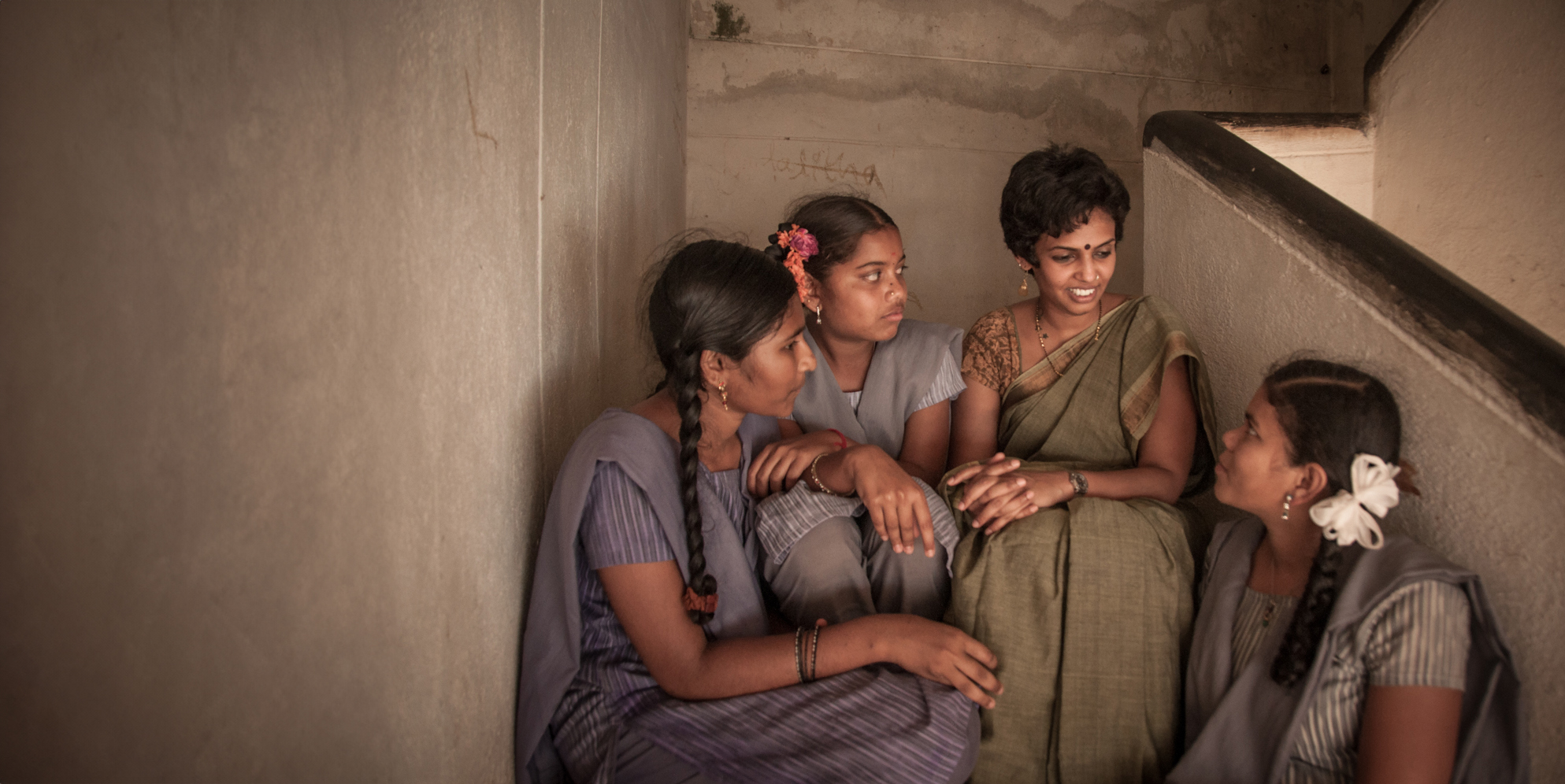Anusha Bharadwaj
Executive Director, Voice 4 Girls
Fellow project website: www.voice4girls.org
How to give millions of the most at-risk young teen girls the understanding and power to reject under-age marriage and worse, and claim a full life including college? That’s what Anusha does, by putting exactly these young women, allied with 19- and 20-year-old college women, in charge.

THE NEW IDEA
Fewer than 16% of Indian women serve in the formal, paid workforce, one of the lowest rates in the world. This is due to deep-rooted social and cultural practices that prevent girls and young women from staying in school, building 21st-century skills, and navigating the world of work. This is especially true for adolescent girls from rural, tribal, and marginalized communities, who start to drop out of school soon after puberty. They are frequently either trafficked or pushed into teenage marriage and parenting well before they turn 18.
Anusha is breaking this pattern wide open. Focusing first on rural and tribal government residential schools, Anusha and her team have innovated a leadership camp and peer mentoring model led by tribal adolescent girls themselves. In these camps, girls are trained as leaders. They identify and strengthen their sense of purpose and autonomy, and they redefine their own sense of where they stand in society. They learn to negotiate with families frozen in the past and to navigate the school-to-work continuum.
They learn to build supportive ecosystems by converting their families and teachers into allies and by supporting one another.
Anusha’s organization Voice4Girls, or V4G, has enlisted some 5,000 19 and 20-year-old new female college students to serve as highly trained leader-mentors. Pairing high-risk rural and tribal girls with urban college women leaders has been an impact-multiplying strategy. It has helped Anusha to scale her model widely across seven states, while deepening local ecosystems of girl solidarity.
Since 2012, V4G has launched 106,505 adolescent girl peer mentors across 695 schools. In turn, these peer-mentors have catalyzed an additional 122,500 girls, in a cascading model of change. Ninety-eight percent of the girls who have participated have pursued higher education, been recruited into jobs, or started their own businesses. Anusha has now been asked by government officials to expand the model to 100 new districts. Anusha seeks to build on this momentum to reach more states and build more civil society partnerships across India.

THE PROBLEM
Nearly 40 percent of adolescent girls in India aged 15-18 years do not attend any educational institutions. Between the ages of 11 to 13, more girls than boys drop out of school. By high school, 57% of girls have left school. This outflow of adolescent girls from the formal schooling systems is a critical trigger for the big gender gap in India’s workforce participation rates.
Deeply held social and cultural norms, with highly gendered expectations and trajectories, underlie these figures. Almost half of India’s 113 million adolescent girls -- 48% -- get married before the age of 18 in rural areas, compared with 29% in urban areas. Uneducated and bargained away, these girls can’t contribute to the country’s productive workforce.
For all practical purposes, most rural adolescent girls lose most of what constitutes a good life the moment they reach puberty. At this stage, the young women are commonly either married off early, trafficked, or pushed into the low-end migrant labor markets.
"Many adolescent girls in India are stuck in...the “cycle of denial,” a vicious cycle in which their rights are denied at every stage of their development…Can this cycle be broken? Voice 4 Girls has proven that it is possible.”
Brookings
Government programs for adolescent girls work in silos. They focus on mechanics -- things like distributing hygiene supplies – and do next to nothing to help girls transition to empowered adulthood. Discussions of bodily changes, menstruation, and sexual health are hushed by teachers who reinforce traditional values of silence and stigma around these topics. Moreover, civil society initiatives for adolescent girls are mostly designed through an adult lens and are rendered by cadres of government teachers and adult facilitators who don’t understand the needs of the girls they are trying to serve.
Adolescent girls, especially in tribal belts, do not have access to programs or counseling that would help them understand the dramatic physical and emotional changes they experience throughout puberty, or help them imagine powerful futures and build strategies to navigate family and societal expectations. All of which helps explain the growing incidence of adolescent girl suicides.
THE STRATEGY
Anusha places adolescent girls at the forefront of her response, believing girls are the best problem-solvers for their own contexts and lives. Anusha especially targets government residential schools that serve girls from the poorest of the poor families. These girls have often been abandoned, raised by very poor single mothers, and/or belong to nomadic and migrant households with little means to provide for them. Focusing on their most vulnerable lifecycle stage, Anusha and her teamwork with girls when they are transitioning from the 7th to the 8th standard (roughly 7th and 8th grades in the U.S.), the point when they are most likely to disappear from the education system.
Over a one-year period, the adolescent girls participate in a set of three leadership camps of ten days each. Every camp is designed as a crucible of real-life scenarios and carries a distinct purpose. The camps are large, with 500-2,000 students participating in one location, with a ratio of one camp counselor (the female college intern) to 30 adolescent girls. At the camps, the girls master 21st-century skills through a gender lens. They hone the competencies of goal-setting, problem-solving, communication, relationship-building, and self-advocacy. Through the entire three-camp experience, the adolescent participants learn how to identify, prevent, and report abuse and violence. They learn about healthy relationships, understand the power of consent, and start to believe that decision-making for their lives lies in their own hands.
“Parichay” (“Introduction”), the first camp, is an introduction to self: One’s body, rights, and safety. At “Disha” (“Direction”), the second camp, girls plan their education, become career-ready, and understand the importance of economic independence. And finally in the third camp, “Sakhi” (“Friend”), the girls realize their leadership potential as peer-mentors.
The backbone of the camps is a well-codified, interactive 250-hour leadership and peer-mentorship curriculum. The curriculum opens safe and de-stigmatized spaces for girls to understand sexual, menstrual, and reproductive health rights. Through 14 core modules, the girls traverse the domains of self, education, employability, leadership, rights, and agency. The pedagogy builds the skills of gender analysis for girls as they unravel the systemic barriers that stop them from pursuing a confident, aspirational, and meaningful life.
All modules are delivered through a “discovery method” of learning, with games and popular local references. Anusha has also integrated stories of local girl and women leaders to provide an alternate sense of what is possible -- that girls can be leaders too and cause lasting change in their communities.
The camp counselors, female students from local colleges who are 19 or 20 years old, are unusual and exceptional partners. As trainers, mentors, and role models, they deliver the transformative leadership curriculum of V4G at scale. In the process, this talent pool of young women trainers experiences leadership and personhood in their own lives as they live the V4G pedagogy.
A rigorous five-day training equips the young counselors to lead the camps so they can deliver critical content with ease and confidence and manage disclosures from girls facing violence and abuse. Anusha and her team have worked hard to simplify complex feminist teaching into accessible modules, which college students can easily learn and convey.
With deep attention to planning and safety, the camps thrive on the unique relationship and energy shared by girls from different age groups and contexts. Inspired by their camp counselor “Akka” (“Big Sister”), the adolescent girls build a shared bank of solutions, tactics, and ideas for creatively and resolutely walking the path to education and work. More and more school principals and government officers acknowledge how effective the young women camp counselors are, more so than the more conservative or traditional teachers. This recognition is building demand for the program. Fifty percent of schools now sign up for multiple years of intervention.
On completion, the girls graduate as Sakhis. Sakhis are champion-friends or peer-mentors who go on to replicate the leadership camp model in their schools with the support of teacher-allies. The Sakhis train, coach, and equip other at-risk girls to change the script of their lives and join in this ever-widening “girl-for-girl” movement.
"I am proud to have attended all three Voice5Girls camps. Using the Sakhi handbooks that we received from camp, a friend and I take classes for small children in our hostel and motivate them as well. Due to all this, my school is now a [model] in my district.” - Participant from Telangana
The Hans India
Anusha’s three-step girl-led program has now been integrated into the government school system as a life skills curriculum. As the camps equip girls to return to their schools with the spirit of paying it forward, adolescent Sakhis facilitate the same camp modules and sessions for their schoolmates. They conduct peer mentoring sessions with other girls and spearhead community action projects to build parent allies. They are aided by a teacher-mentor in each school who creates space in the school routine for girls-led sessions, group mentorship programs, and other supportive projects with families and communities. In these ways, the young Sakhis widen the hyper-local girl solidarity network with the support of teachers and others in the school system.

This girl-led model has registered clear behavior-change outcomes. Ninety-nine percent of the girl participants attend all three camps. This is also an indication that they aren’t dropping out of school at the critical time when they are most vulnerable. Almost all the girls pursue higher education after the camps, while successfully negotiating marriage proposals and challenging domestic violence. Many Sakhis also cultivate safe spaces and solidarity circles in their communities, including a forum of mothers against child marriages.
Forty percent of the college women who serve as camp counselors re-engage with Anusha and her team in subsequent years. Most share testimonies of enhanced personhood and autonomy. Twenty percent of them have chosen sectors of social impact for their future work, taking forward the mandate of a world where girls stand up for each other. To strengthen this resource pool of young women changemakers, Anusha has launched “Soch for Social Change” Fellowships, a feminist leadership academy for young women from smaller cities.

Anusha has leveraged the massive outreach of the Indian government’s network of residential schools, as well as its tribal and social welfare schools, to transform the most hard-to-reach communities. The V4G curriculum has been integrated into the state-wide social welfare and tribal schools, as well as in the adolescent girl programs of the state of Telangana state. Impressed by the visible behavior change in the girls at the end of the camps, government officials have invited Anusha to launch her module in 100 new districts across the country.
Partnerships with government school systems are now propelling the spread of Anusha’s model. In Telangana, where the model is the most mature, the state government mobilizes participants, co-funds the trainings, and champions the V4G leadership camp program.
Connecting with the government has enabled Anusha to keep her model extremely cost-effective, as the government bears the costs of food, lodging, and transport while Anusha raises capital for her staff travel and training. As of today, the cost of impact per girl for the entire three camps ranges from 10-15 USD.
Lifted by the response and the demand from the ground, Anusha has launched a model for adolescent boys, affecting 15,000 of them already through the camp model. Over the next five years, Anusha aims to multiply her model’s reach triplicate her model by deepening her collaborations and by integrating the V4G approach into a growing number of large-scale existing programs.
THE PERSON
Anusha was the first girl born in her family after generations. Her birth was a massive disappointment for the extended family. Her father did not see her face for days and her mother, who had delivered Anusha in her natal home, feared she would not be allowed back into her marital family. Though her father fell in love with Anusha when he finally visited her after much prompting by his in-laws, the scar of the initial rejection stayed with Anusha. She grew up surrounded by an army of cousins and brothers who constantly reminded her of her limits as a girl.
Unsurprisingly, Anusha grew up a rebel, challenging definitions and boundaries. As a young woman, she chose to play competitive national cricket -- a male-dominated sport -- walking shoulder to shoulder with the current Indian team captain Mithali Raj. All her choices were colored by her inner fight to excel in every masculine domain, including pursuing engineering, which ended up being “an excruciating experience” for Anusha. She went through the academic grind without ever connecting with the subject. This was when she realized that she had set herself up to a poor benchmark “of being like a boy.” This insight fired her up to be an authentic young girl, with her own voice and dreams.
Anusha changed her trajectory to work in the non-profit sector. Working with young girls came naturally to her, and she went on to engage with some of the largest, game-changing social sector leaders and programs of the day. After completing an MBA in rural management and a master’s degree in sociology, in 2010 she was appointed by the government of Andhra Pradesh (now Telangana and Andhra Pradesh) to lead and design a comprehensive school health program and policy that eventually spread across 85,000 schools, reaching 10 million students. Anusha launched this program, managing massive multi-stakeholder partnerships. This intense engagement with the government system taught Anusha critical lessons on partnering with state government bodies.
It was at a village meeting on nutrition for pregnant women, that Anusha spotted a heavily pregnant girl of 13-14 years of age. The image stirred her deeply. She kept thinking of how this teenage mother would soon become invisible, either trafficked or destined for low-end migrant labor. This destiny was not acceptable to Anusha. This creative anger led Anusha to give Voice4Girls a whole new direction after its original founders from the U.S. quit in the early years of setting up the organization. Anusha rebuilt the organization from scratch, with a fresh vision and mission statement, and fought enormous battles to keep the non-profit afloat in the early years.
As a social entrepreneur, Anusha lives the power and deep satisfaction of being what she is bringing to the most vulnerable young women when they are at maximum risk as well as to thousands of young college women. It is no surprise that the heart of how she is changing one of society’s most deep-rooted patterns is by looking to these young women themselves.